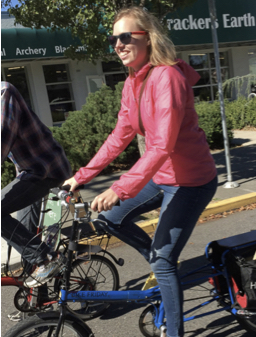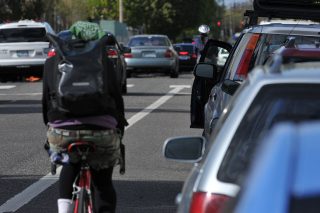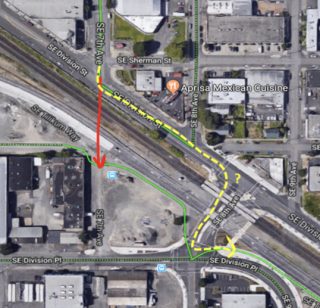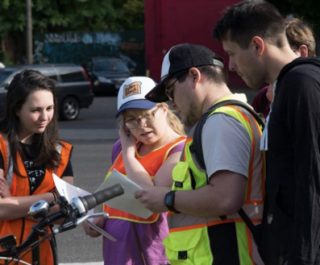[Publisher’s note: I’m happy to introduce a new column — Adventures in Activism — to highlight more of the vital, in-the-trenches work of grassroots activists. The column will be edited by BikeLoudPDX volunteers Emily Guise and Catie Gould; but they won’t be the only writers. If you’re working to make streets better, please get in touch so we can share your voice. In this first post, Emily and Catie share how they got involved. Stay tuned and thanks for reading. – Jonathan]
——

(Photo: Jonathan Maus)
➤ by Emily Guise
My bike advocacy career started on North Williams Avenue. In 2011, I was living in inner north Portland, had just started a new job downtown, and was going to school in Gresham. I rarely rode during rush-hour before; but now I was part of the pack going in-and-out of the central city. I began to hate my bike commute: people behaved dangerously, traffic was noisy, and I felt scared riding in skinny bike lanes. Riding up Williams was the worst. Its thin bike lane was sandwiched between impatient rush-hour commuters in big SUVs and parked cars whose drivers obliviously flung their doors open. Having to be on high-alert just to get home safely was exhausting. I disliked how angry I felt while biking and I knew I couldn’t continue this way.
After finding BikePortland.org from a Google search, I had become an obsessive reader, checking it often, trying to understand how transportation worked in Portland. Why were things that seemed so simple to me so hard to do? I wanted to add more bike lanes! Make them feel safer! Have them go where people want to travel! But it felt like howling into a void.
So when I saw the Williams Ave project open house announcement on BikePortland, I had to go. I was overjoyed to hear that the street I despised was going to be redesigned.

(Photo: Jonathan Maus)
I wanted a complete redesign: protected bike lanes, less bus/bike interactions, distance from the loud, large vehicles and distracted drivers, and better parking management. It took all of my willpower to not rant at the Portland Bureau of Transportation (PBOT) employees working at the event about the many failings of the street. I felt more passionate about this project than I had about anything for years. It took me completely by surprise.
I learned a lot on the Williams project — not just about streets, but about the importance of understanding how they’re used and who uses them. In the end, the redesign didn’t include everything I wanted, but that only fueled my desire to participate more and fight harder next time.
This passion was why, in August 2014, I found myself at a pub with about 40 other people who were also interested in making Portland better for biking. It was the start of a new group that would be named BikeLoudPDX (which just so happens was started by Alex Reed in a BikePortland comment thread).

(Photo: Jonathan Maus)
I was shy about my lack of experience and I almost didn’t go to that first meeting. I knew that I wanted to channel my anger into something positive, and it seemed like getting together with like-minded people was the best way to do it. Being with other people who could talk as obsessively as I could about bike stuff — and who had a better grasp on the history and context of bike advocacy in this city than I did — was electrifying. I wanted more.
After BikeLoudPDX found momentum in their fight for upgrades to the SE Clinton Street neighborhood greenway, I felt even more inspired. The new diverters we helped get installed made a real difference to people’s safety. I felt a sense of community, which had been lacking in my life since moving to Portland in 2008. I’d been looking for my people, and it felt like I’d finally found them.
Advertisement
➤ by Catie Gould

(Photo courtesy Catie Gould)
I bought my first adult bike when I moved to Portland in 2012. I lived right off Clinton Street and was following the parking debates along SE Division in the SE Examiner newspaper. That’s where I saw the notice for a meeting series about the new Orange Line light rail project. I rode to the Willamette River often, but to get there I had to turn onto Division for a few blocks. It was my least favorite segment and I thought maybe, just maybe, I could help get it fixed.
I walked into the meeting alone, and nervously brought up the lack of a bike connection as we introduced ourselves around the table. Turns out PBOT was working on a bike improvement, but it had only been added to the plan a few weeks prior.
At a later meeting a planner rolled out the blueprint of the new SE 8th and Division intersection across a table for me to look at. “This intersection doesn’t make sense to me. I would want to bike this way,” I said, tracing my fingers over the blueprint. “It’s too late, the construction has already started. It was a lot of work to negotiate with the railroad,” the staffer replied.

Lesson #1: Most of advocacy work is timing.
I was unsure if my feedback had made any difference, but it felt like I had been close. I signed up for project email lists, and attended any public meeting that looked interesting. I often felt like I was in the wrong place and asking questions everyone else already knew the answer to.
Meanwhile, I embraced all things bike. Pedalpalooza became my primary vehicle for making new friends. I struggled through the beginners’ field in cyclocross racing, firmly holding down the end of the pack. Another racer, Rebecca Hamilton, brought me to BikePortland Wonk Nights where I met other people who discussed transportation policy for fun.
I could no longer deny I was falling down a rabbit hole when I kept taking photos of intersections while travelling through Europe. While Portland’s bike share had been put on hold again, I rode on systems in Stockholm, Paris, and Tel Aviv. I rode with the rush-hour flow, changing direction only when I had gone too far.

I rerouted my trip to be in Paris for the first “Journée sans ma voiture” (Day without a car), one of the initiatives spurred by record levels of smog that encircled the Eiffel Tower six months earlier. I kept riding outside of the zone and taxis were still allowed, but the transformation was clear to see and hear.
I returned to Portland as winter began, feeling adrift. Hoping for inspiration and connections, I took a day off to attend the 2016 Oregon Active Transportation Summit (OATS), and that’s exactly what I got. I sat next to Ted Buehler at lunch, a co-chair of BikeLoudPDX, then I went to a presentation by Better Block PDX in the afternoon. Each of their projects seemed more effective than the meetings I was attending; implemented at a speed the city couldn’t match. A few months later, I was lugging traffic cones up and down Broadway to help create a temporary protected bike lane and floating bus island on a major commercial street.
The two years since have been a blur.
In Portland, while transportation innovation is seemingly stuck in traffic, new advocacy organizations have emerged to push the city forward. The Portland Bus Lane Project, Andando en Bicicletas en Cully, BikeLoudPDX, Better Block PDX and others have come to the forefront in the past five years.
The next few years are going to be a wild ride with potentially game-changing projects all over the city. If Portland joins the urbanization revolution sweeping cities around the world, it will only be because of citizens who care and keep asking for more.
BikeLoudPDX is excited to bring you this column. It took a village to inspire us to get more involved with advocacy, now want to help to help more people learn how to transform our city.
— Catie Gould and Emily Guise
Never miss a story. Sign-up for the daily BP Headlines email.
BikePortland needs your support.
